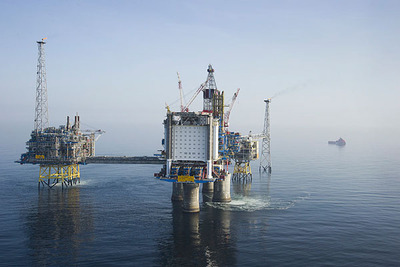Earthquake risks for CCS, fracking and wastewater injection wells
A paper by Stanford University geophysicists Professor Mark Zoback and Professor Steven Gorelick has claimed that carbon capture and storage (CCS) has a high probability of triggering earthquakes where large volumes of carbon dioxide are injected into the brittle rocks commonly found in continental interiors. The process of CCS involves collecting CO2 from power plants, liquefying it, and pumping it at high rates into deep underground geologic formations for permanent disposal.

While the earthquakes themselves would be too small to cause major damage, the researchers note that “even small to moderate-sized earthquakes threaten the seal integrity of CO2 repositories,” meaning the CO2 could escape into the atmosphere and render the process useless. They therefore conclude that “large-scale CCS is a risky, and likely unsuccessful, strategy for significantly reducing greenhouse gas emissions”.
A recent report from the US National Research Council also considers the potential for CCS to induce seismic events, because significant volumes of fluids are injected underground over long periods of time. But insufficient information exists to fully understand this potential, because no large-scale projects are as yet in operation. The committee that wrote the report says continued research will be needed to examine the potential for induced seismicity in large-scale CCS projects.
The report also looked into the process of hydraulic fracturing (‘fracking’), indicating that it carries a low risk for inducing earthquakes that can be felt by people; but that the underground injection of wastewater produced by this and other energy technologies has a higher risk of causing such earthquakes. Fracking extracts natural gas by injecting a mixture of water, sand and chemicals in short bursts at high pressure into deep underground wells. The process cracks the shale rock formation and allows natural gas to escape and flow up the well, along with some wastewater. The wastewater can be discarded in several ways, including injection underground at a separate site - it is this which is more likely to trigger seismic activity, and not, as Zoback points out in an article written in April this year, the initial water injection process.
Zoback’s article acknowledges that “we have known for more than 40 years that earthquakes can be triggered by fluid injection” - and that a number of small-to-moderate earthquakes that occurred in the US in 2011 may have been associated with the disposal of wastewater - but said that, “No earthquake triggered by fluid injection has ever caused serious injury or significant damage.” However, the NRC report notes that some of the effects of these earthquakes have been felt by local residents in the US and have raised concern about additional seismic activity and its consequences in areas where energy development is ongoing or planned. Furthermore, scientists are unable to accurately predict the magnitude or occurrence of these earthquakes due to insufficient information about the natural rock systems and a lack of validated predictive models at specific energy development sites.
There are several methods which can be put in place to lower the risk of seismic activity as a result of fluid injection. In Zoback’s article he provides five steps to reduce this risk: 1) Avoid injection into active faults; 2) Minimise pore pressure changes at depth; 3) Install local seismic monitoring arrays; 4) Establish modification protocols in advance; 5) Be prepared to alter plans or abandon wells. Meanwhile, the NRC committee puts an emphasis on using technologies designed to balance the amount of fluid introduced or removed underground, as it is this injection and withdrawal which provides the potential to induce earthquakes. The report further indicates that cooperation between the federal and state agencies which have regulatory oversight to different aspects of underground injection activities is warranted.
Zoback has said that there will still be a use for CCS at a small scale, in regions that are near both CO2-producing plants and suitable geologic formations, but that large-scale CCS is too high risk for the world to seriously consider as a solution to the greenhouse gas problem. If this is indeed the case, it is imperative that an alternative solution is developed - ideally one which reduces greenhouse gas emissions without causing or being affected by earthquakes in the process.
Berrima Cement Works upgrades with sustainable tech
Boral has unveiled new carbon-reducing technology at the site, which supplies 40% of cement in...
Australian orgs partner to speed circular economy
GS1 Australia has joined forces with the Product Stewardship Centre of Excellence to drive the...
Victorian utility recognised at Asian Water Awards
South East Water won two awards for its Hydrotrak Geofencing technology, which has helped it to...







